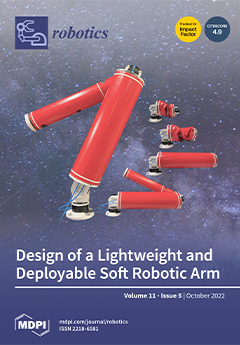Open AccessArticle
Preliminary Experimental Results of Context-Aware Teams of Multiple Autonomous Agents Operating under Constrained Communications
by
Jose Martinez-Lorenzo, Jeff Hudack, Yutao Jing, Michael Shaham, Zixuan Liang, Abdullah Al Bashit, Yushu Wu, Weite Zhang, Matthew Skopin, Juan Heredia-Juesas, Yuntao Ma, Tristan Sweeney, Nicolas Ares and Ari Fox
Viewed by 1530
Abstract
This work presents and experimentally tests the framework used by our context-aware, distributed team of small Unmanned Aerial Systems (SUAS) capable of operating in real time, in an autonomous fashion, and under constrained communications. Our framework relies on a three-layered approach: (1) an
[...] Read more.
This work presents and experimentally tests the framework used by our context-aware, distributed team of small Unmanned Aerial Systems (SUAS) capable of operating in real time, in an autonomous fashion, and under constrained communications. Our framework relies on a three-layered approach: (1) an operational layer, where fast temporal and narrow spatial decisions are made; (2) a tactical layer, where temporal and spatial decisions are made for a team of agents; and (3) a strategical layer, where slow temporal and wide spatial decisions are made for the team of agents. These three layers are coordinated by an ad hoc, software-defined communications network, which ensures sparse but timely delivery of messages amongst groups and teams of agents at each layer, even under constrained communications. Experimental results are presented for a team of 10 small unmanned aerial systems tasked with searching for and monitoring a person in an open area. At the operational layer, our use case presents an agent autonomously performing searching, detection, localization, classification, identification, tracking, and following of the person, while avoiding malicious collisions. At the tactical layer, our experimental use case presents the cooperative interaction of a group of multiple agents that enables the monitoring of the targeted person over wider spatial and temporal regions. At the strategic layer, our use case involves the detection of complex behaviors, i.e., the person being followed enters a car and runs away, or the person being followed exits the car and runs away, which require strategic responses to successfully accomplish the mission.
Full article
►▼
Show Figures





